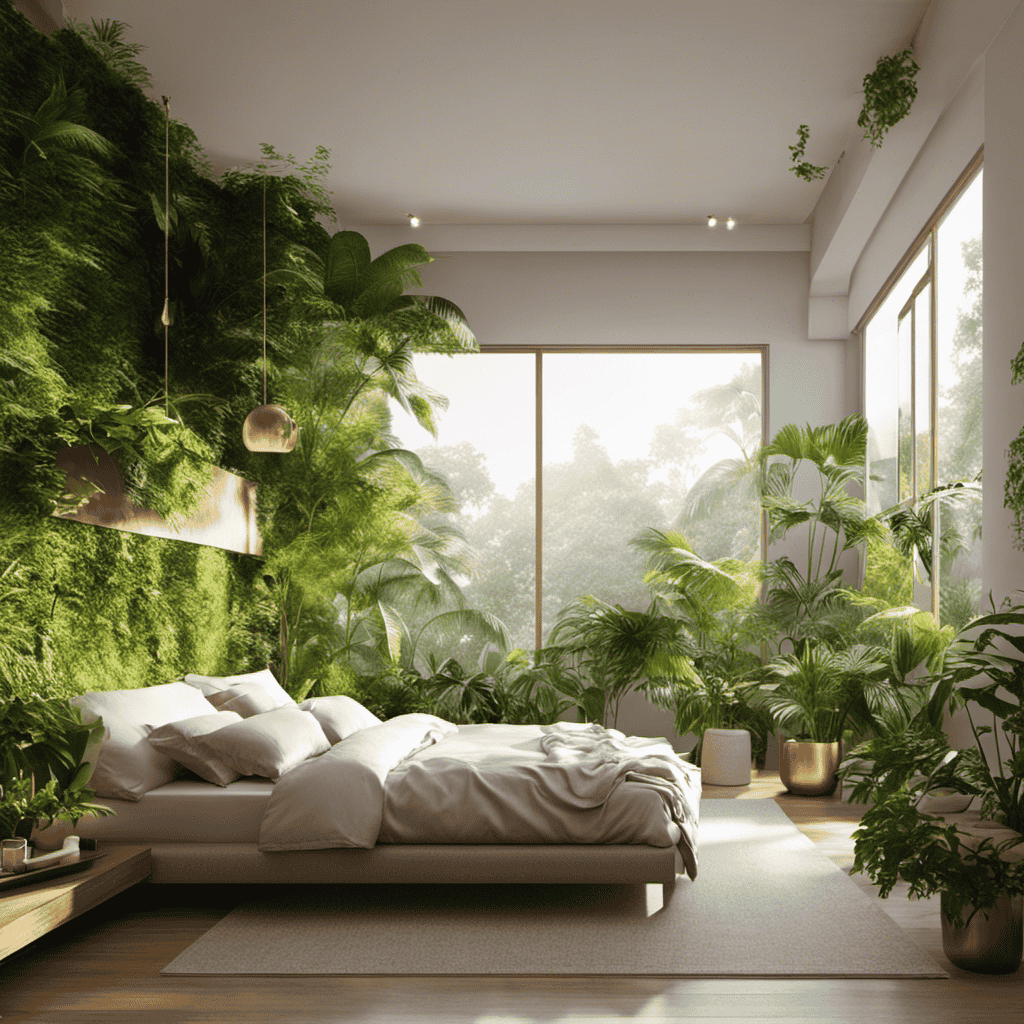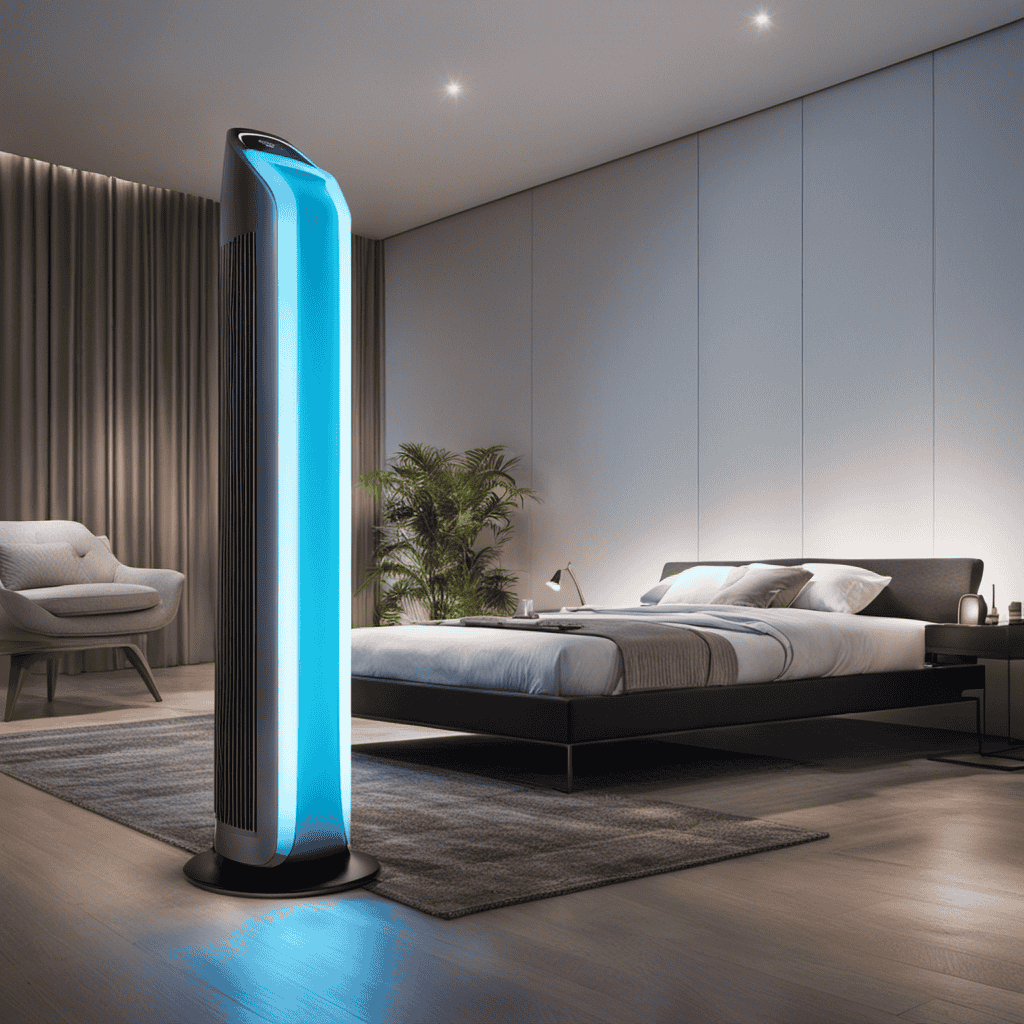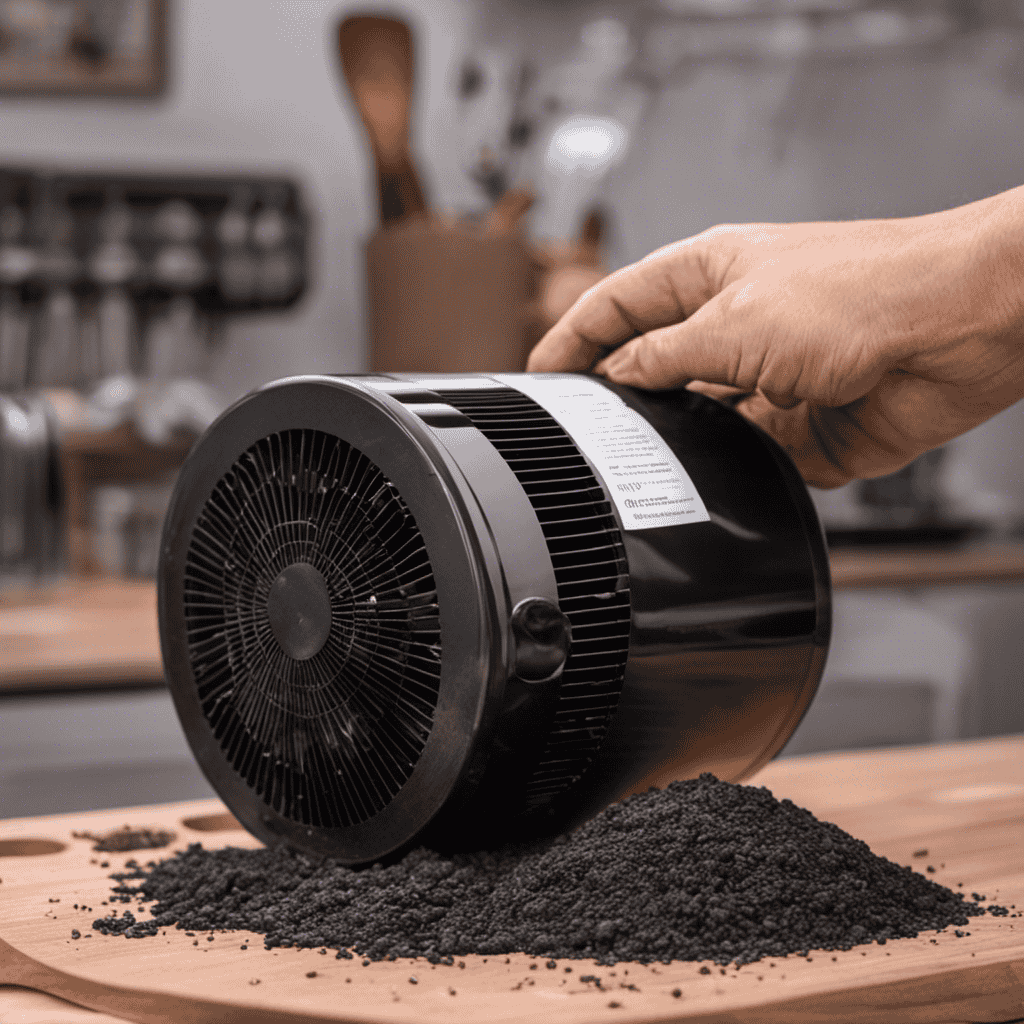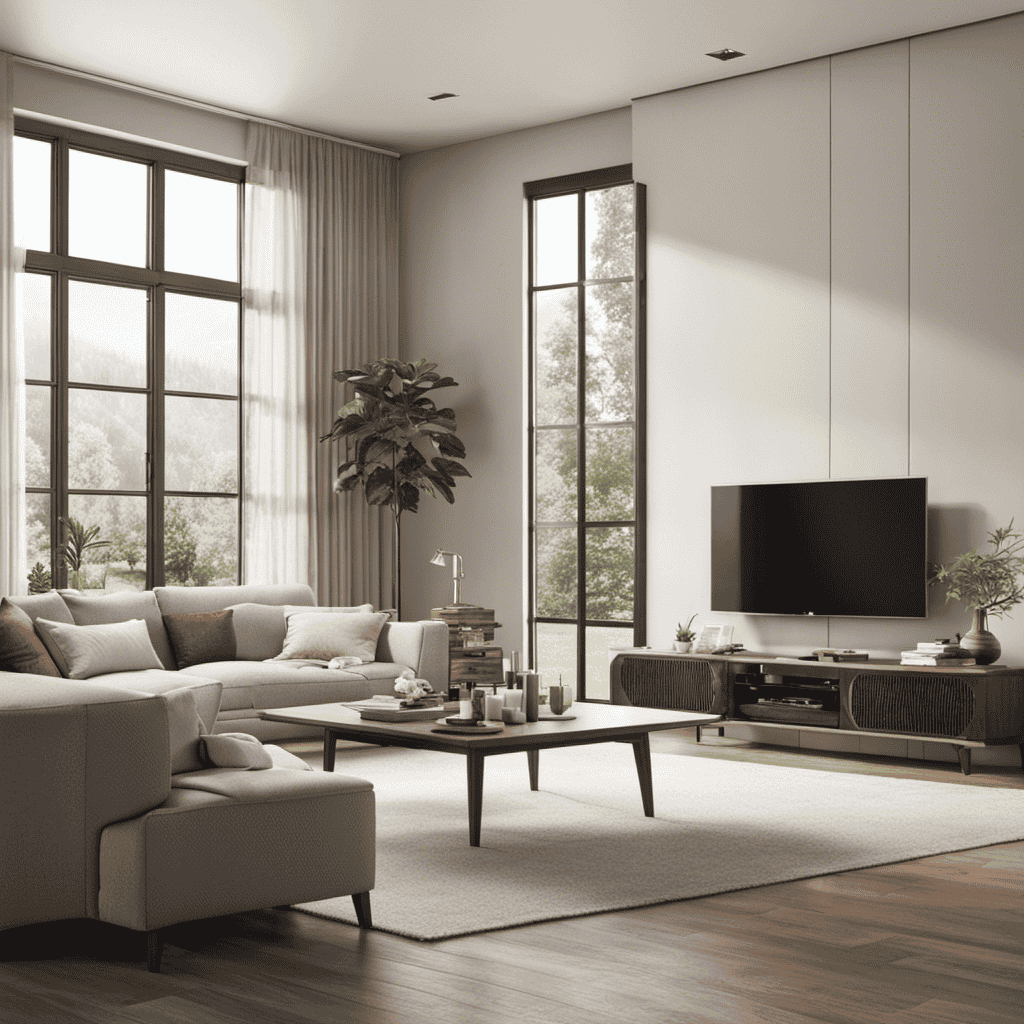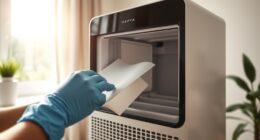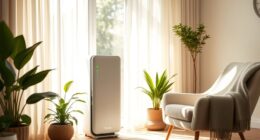As an individual who has dealt with allergies and low air quality, I understand firsthand the significance of properly utilizing an air purifier.
In this article, I will guide you through the ins and outs of maximizing the benefits of your air purifier. From understanding its functions to troubleshooting common issues, I’ll provide you with the knowledge and tools to create a healthier and cleaner environment.
Let’s dive in and discover how to make the most out of your air purifier.
Key Takeaways
- Regular maintenance is crucial for optimal performance of an air purifier, including cleaning or replacing filters and dusting the unit.
- Air purifiers reduce allergies and asthma symptoms, eliminate odors, and create a healthier living environment.
- Choosing the right air purifier with features like HEPA filters, UV-C light, and activated carbon is important.
- Proper placement and positioning of the air purifier in the room optimize its performance.
Understanding the Air Purifier Functions
To effectively understand how your air purifier functions, you’ll need to read the user manual thoroughly.
Air purifiers are designed to improve indoor air quality by removing pollutants, such as dust, pet dander, pollen, and smoke particles.
Regular maintenance is crucial to ensure optimal performance. This includes cleaning or replacing the filters as recommended by the manufacturer, as well as regularly dusting and vacuuming the unit to prevent buildup.
The benefits of using an air purifier are numerous. It helps to reduce allergies and asthma symptoms, eliminates odors, and creates a cleaner and healthier living environment.
By properly maintaining your air purifier, you can ensure that it continues to provide these benefits effectively.
Now, let’s move on to the next section and discuss how to choose the right air purifier for your needs.
Choosing the Right Air Purifier for Your Needs
When it comes to choosing the right air purifier for your needs, there are a few key factors to consider.
First, you’ll want to look at the purifier features that are important to you. Whether it’s a HEPA filter, UV-C light, or activated carbon, understanding the different features available will help you make an informed decision.
Additionally, considering the size of the room where you plan to use the purifier is crucial. Different purifiers are designed to handle different room sizes, so it’s important to choose one that can effectively clean the air in your space.
Purifier Features for You
You can choose an air purifier with features that suit your needs and preferences. When it comes to selecting an air purifier, there are several features to consider. Here are three key features that can enhance your air purifier experience:
-
Smart Technology: Look for air purifiers that come with smart features such as Wi-Fi connectivity and smartphone compatibility. This allows you to control and monitor your purifier remotely, making it convenient and easy to use.
-
Noise Reduction: If you value a quiet environment, opt for an air purifier with noise reduction technology. These models are designed to operate quietly, ensuring minimal disruption to your daily activities or sleep.
-
Filter Replacement Indicator: It can be easy to forget when to replace the filters in your air purifier. Look for models that have a filter replacement indicator. This feature will alert you when it’s time to replace the filters, ensuring optimal performance.
Considering these features will help you find the perfect air purifier for your specific needs.
Now, let’s explore the next consideration: room size.
Room Size Considerations?
One important factor to consider is the size of the room you plan to use the air purifier in. The room size plays a crucial role in determining the effectiveness of the air purifier’s performance. A larger room would require a more powerful air purifier to effectively clean the air, while a smaller room may be adequately served by a smaller unit. To help you choose the right air purifier for your room size, refer to the table below:
| Room Size | Recommended Air Purifier Size |
|---|---|
| Small (up to 150 sq ft) | Compact or Mini Air Purifier |
| Medium (150-300 sq ft) | Medium-sized Air Purifier |
| Large (300+ sq ft) | Large or Whole-house Air Purifier |
Considering the room size when selecting an air purifier will ensure that you get the best performance and cleanest air possible.
Placement and Positioning of Your Air Purifier
To effectively use your air purifier, it’s important to consider the placement and positioning. Proper placement ensures that the air purifier can efficiently clean the surrounding air and provide you with clean, fresh air to breathe.
Here are three key factors to consider when placing your air purifier:
-
Distance from walls: Place your air purifier at least a few inches away from the walls to allow proper airflow and circulation. This will ensure that the purifier can effectively capture and remove airborne pollutants from the room.
-
Height placement: Position your air purifier at an elevated level, such as a table or shelf, to maximize its coverage. Placing it higher up allows the purifier to better capture pollutants that may rise in the air.
-
Central location: Choose a central location in the room to place your air purifier. This allows for even distribution of purified air throughout the space, ensuring that all corners are covered.
By considering these placement and positioning factors, you can optimize the performance of your air purifier and enjoy the numerous benefits it offers, such as improved indoor air quality and reduced allergy symptoms.
Regular air purifier maintenance, such as changing filters and cleaning the unit, is also crucial for optimal performance.
Setting Up and Installing Your Air Purifier
Now that we have discussed the importance of placing your air purifier in the right location, let’s move on to the next step: setting up and installing your air purifier.
This process is relatively straightforward and can be done by following a few simple steps.
First, carefully unpack your air purifier and remove any packaging materials.
Next, find a suitable location for your purifier, preferably near a power outlet. Make sure to leave enough space around the unit to allow for proper air circulation.
Once you have positioned your air purifier, plug it into the power outlet and turn it on. Most air purifiers have a control panel or remote that allows you to adjust the settings according to your preferences.
In terms of maintenance, it is important to regularly clean or replace the filters in your air purifier. This will ensure that it continues to effectively remove common air pollutants such as dust, pollen, pet dander, and smoke particles.
Operating and Controlling the Air Purifier
Once you’ve positioned your air purifier and plugged it in, you can easily control its settings using the control panel or remote.
The control panel is conveniently located on the front of the purifier and provides quick access to all the functions. Alternatively, the remote control allows you to adjust the settings from anywhere in the room.
Here are some operating instructions to help you get started:
- Press the power button to turn the air purifier on or off.
- Use the fan speed button to adjust the airflow intensity.
- Set the timer to automatically turn off the purifier after a certain period of time.
By familiarizing yourself with these simple steps, you’ll be able to optimize the performance of your air purifier and create a healthier indoor environment.
Now, let’s move on to the next section about maintaining and cleaning your air purifier.
Maintaining and Cleaning Your Air Purifier
Regular maintenance and cleaning of your air purifier is essential for ensuring its optimal performance and longevity. By properly maintaining your air purifier, you can extend the lifespan of its filters and improve the quality of the air in your home.
To start, make sure to check the manufacturer’s instructions for specific maintenance guidelines. Typically, you will need to clean or replace the pre-filter every three to six months, depending on the level of pollutants in your environment. Additionally, the HEPA filter should be replaced every 12 to 18 months.
Regularly vacuuming the exterior and wiping down the control panel will also help keep your air purifier in top condition. By following these maintenance tips, you can keep your air purifier running efficiently and effectively, ensuring that you and your family breathe clean and healthy air.
When it comes to replacing filters in your air purifier, it is important to know the right time to do so.
Replacing Filters in Your Air Purifier
When it’s time to replace filters in your air purifier, it’s important to follow the manufacturer’s guidelines for optimal performance. Proper air filter maintenance is crucial in extending the lifespan of your filters and ensuring that your air purifier continues to effectively remove pollutants from your indoor air.
Here are three key tips to keep in mind when replacing your air purifier filters:
-
Regularly check the filter indicator: Most modern air purifiers are equipped with filter indicator lights that will signal when it’s time to replace the filters. Pay attention to these indicators to ensure timely replacement.
-
Use high-quality filters: Investing in high-quality filters can greatly enhance the performance and longevity of your air purifier. Look for filters that are specifically designed for your model and are capable of trapping a wide range of pollutants.
-
Follow the recommended replacement schedule: Manufacturers provide recommended replacement schedules for their filters based on usage and air quality. It’s important to stick to these guidelines to ensure optimal filtration efficiency.
By following these tips, you can maintain your air purifier and extend the lifespan of your filters, ultimately maximizing the effectiveness of your air purifier in improving indoor air quality.
Now, let’s delve into the various features and modes that you can utilize to further enhance your air purifier’s performance.
Using Additional Features and Modes of Your Air Purifier
Now that you know how to replace the filters in your air purifier, let’s explore some of the additional features and modes that can enhance its effectiveness.
Maintaining your air purifier is crucial for optimal performance, so familiarizing yourself with these advanced features is essential.
Many modern air purifiers come equipped with features such as a timer, sleep mode, and auto mode. The timer allows you to set a specific duration for the purifier to run, conserving energy when not needed.
Sleep mode reduces fan speed and noise levels during nighttime use, ensuring a peaceful sleep environment. Auto mode automatically adjusts the fan speed based on the air quality in the room, providing efficient and tailored purification.
By utilizing these advanced features, you can customize your air purifier’s performance to suit your needs and maintain a clean and healthy indoor environment.
Now, let’s move on to the next section and learn how to monitor the air quality with your air purifier.
Monitoring the Air Quality With Your Air Purifier
Utilizing the built-in air quality monitor, you can easily track the indoor air quality with your purifier. This feature allows you to stay informed about the effectiveness of your air purifier and make necessary adjustments for optimal performance.
Here are some important points to consider for monitoring the air quality with your air purifier:
-
Real-time feedback: The air quality monitor provides real-time feedback on the current state of your indoor air. It measures the levels of pollutants such as dust, pollen, and pet dander, giving you a clear understanding of the air quality.
-
Maintenance reminders: Some air purifiers with air quality monitors come with maintenance reminders. These reminders prompt you to clean or replace the filters, ensuring that your purifier continues to perform at its best.
-
Adjustments and settings: With the information provided by the air quality monitor, you can adjust the settings on your air purifier accordingly. If the air quality is poor, you can increase the fan speed or activate specific modes to improve the purification process.
Maximizing Energy Efficiency of Your Air Purifier
To maximize the energy efficiency of your air purifier, you should consider setting it to the lowest fan speed when the air quality is good. This not only ensures that your air purifier is using less electricity, but also helps to prolong the lifespan of the device.
Additionally, you can follow these energy saving tips to further reduce electricity consumption:
-
Keep your air purifier clean and dust-free. Regularly clean or replace filters to maintain optimal performance.
-
Place your air purifier strategically. Keep it away from heat sources and direct sunlight to prevent unnecessary energy usage.
-
Use a timer or smart plug. Set your air purifier to run only when needed, such as during high pollution hours or when you’re at home.
-
Consider the size of your room. Using a purifier that is appropriate for the room size can prevent unnecessary energy consumption.
Troubleshooting Common Issues With Your Air Purifier
When it comes to maintaining the effectiveness of your air purifier, two key factors to consider are the frequency of filter replacements and the elimination of strange odors.
Regularly replacing the filters in your air purifier is crucial to ensure that it continues to remove pollutants effectively.
Additionally, if you notice any strange odors coming from your air purifier, it is important to address the issue promptly to prevent any further complications.
Filter Replacement Frequency
The frequency of filter replacement depends on the air quality and usage. To extend the lifespan of your air purifier’s filters and save money on filter replacements, consider the following:
-
Regular cleaning: Vacuum or wipe down the pre-filter and outer surfaces of the air purifier to remove dust and debris. This helps prevent clogging and prolongs the life of the filters.
-
Air quality monitoring: Use a dedicated air quality monitor to keep track of the pollutants in your indoor environment. By monitoring the air quality, you can adjust the usage of your air purifier and determine when the filters need replacement.
-
Filter maintenance: Some air purifiers come with washable or reusable filters. Regularly clean and maintain these filters according to the manufacturer’s instructions to extend their lifespan and reduce the frequency of replacements.
Strange Odor Elimination
If you notice a strange odor, try cleaning the filters and wiping down the surfaces of your air purifier to eliminate the smell. Odors can build up over time, especially if you have pets or do a lot of cooking. Cleaning the filters is essential for maintaining the effectiveness of your air purifier. Wiping down the surfaces with a damp cloth will help remove any residual odors. Additionally, consider using activated carbon filters, which are designed to specifically target and eliminate odors. These filters contain small pores that trap odor molecules, leaving the air in your home fresh and clean. By regularly cleaning your filters and using activated carbon filters, you can effectively eliminate pet odors and remove cooking smells from your home.
| Odor Elimination Tips |
|---|
| Clean filters |
| Wipe down surfaces |
| Use activated carbon filters |
Frequently Asked Questions
Can I Use My Air Purifier in a Small Enclosed Space Like a Closet or Bathroom?
Yes, you can use an air purifier in a small enclosed space like a closet or bathroom. It is important to ensure proper air purifier maintenance and understand the benefits of using an air purifier in small spaces.
How Often Should I Clean the Exterior of My Air Purifier?
I clean the exterior of my air purifier regularly to maintain its efficiency. The cleaning frequency depends on the environment, but a general rule is to clean it at least once a month. I use a damp cloth to wipe away dust and debris.
Is It Safe to Use an Air Purifier Around Children and Pets?
Yes, it is safe to use an air purifier around children and pets. Regular air purifier maintenance ensures optimal performance. The benefits of using an air purifier include removing allergens, dust, and pet dander from the air, creating a cleaner and healthier environment.
Can an Air Purifier Remove Odors From Cooking or Smoking?
Yes, an air purifier can effectively remove odors from cooking or smoking. I have personal experience using an air purifier for allergies and pet dander, and it has been very effective in eliminating unwanted odors in my home.
How Long Does It Typically Take for an Air Purifier to Improve Air Quality in a Room?
Improving indoor air quality with an air purifier can take a few hours to notice a difference. The benefits of using an air purifier include reducing allergens, eliminating odors, and improving overall respiratory health.
What Are Some Common Mistakes People Make When Using Air Purifiers?
When it comes to using air purifiers correctly, some common mistakes people make include placing the purifier in the wrong location, neglecting to regularly clean or replace the filters, and not running the purifier for a sufficient amount of time. These mistakes can hinder the effectiveness of the air purifier.
Can DIY Ionic Air Purifiers Be as Effective as Store-Bought Ones?
When it comes to air purification, many wonder if they can learn to make air purifier that is as effective as store-bought models. While DIY ionic air purifiers can be cost-efficient, they may not offer the same level of filtration and air cleaning as their commercial counterparts.
Conclusion
Well, folks, there you have it – your ultimate guide to using an air purifier effectively.
Now, I know what you’re thinking – ‘Wow, this article has changed my life!’ And you’re absolutely right! Who knew that a simple machine could have such a profound impact on our air quality?
But fear not, dear readers, for armed with this newfound knowledge, you can now conquer the world of clean air.
So go forth, my friends, and breathe in that wonderfully purified air with pride!
